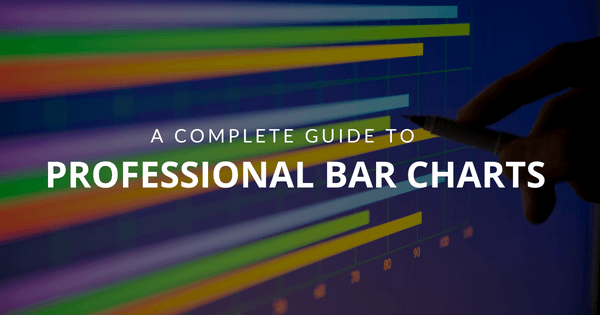
In today’s fast-paced analytical landscape, data visualization has become one of the most powerful tools organizations can benefit from to be successful with their analytical efforts. By using different types of graphs and charts, businesses can make their data more understandable which also makes it easier to extract powerful insights from it.
At datapine, we believe that in order to successfully utilize the various data visualizations we have available, it is necessary to identify the advantages and disadvantages of each graphic to make sure you are using them in the correct way. For that purpose, we are creating a series of blog posts that will take an in-depth look at the most common types of graphs and charts out there and explore their main uses through insightful business examples. We started this series with gauge charts, now it’s the turn of one of the most common charts: the bar chart.
Here, you’ll learn the definition, its advantages in a business context, common types and their use cases as well as an insightful list of examples for different functions and industries. Let’s dive in with the definition.
What Are Bar Charts & Graphs?
A bar graph is a graphical representation that uses rectangular bars with diverse sizes to compare different values of categorical data. The bars on a bar chart can be horizontal or vertical, but the vertical version is most commonly known as a column chart.
As mentioned above, bar graphs can be plotted using horizontal or vertical bars. For the purpose of this post, we will only focus on horizontal bars. As vertical ones are a different type of visual known as a column chart and we will do an in-depth analysis on that one as a standalone chart soon.
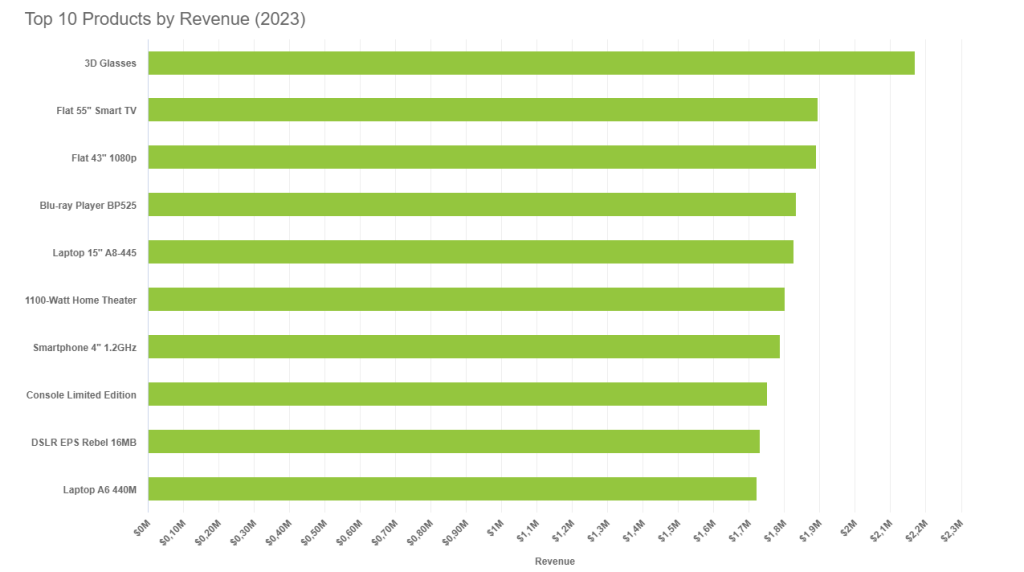
Typically, a bar chart displays a categorical variable on the y-axis (vertical) with comparable numerical values that are displayed on the x-axis (horizontal). The categories are usually qualitative data such as products, years, product categories, countries, etc. that are being compared based on specific criteria. This is represented by the example above, in which we can see the top 5 products by sales where the length of the horizontal bars are corresponding to the size of the values. Making it a great visual to extract conclusions about product development.
Disadvantages & Advantages Of Bar Graphs
Just like any data analysis technique, bar graphs have advantages and disadvantages to them. It is important to recognize and understand these as they will enable you to gain a deeper understanding of when it is appropriate to benefit from this visual. Let’s begin with two key advantages of bar graphs.
- Summarize large data sets: Due to their horizontal orientation, a bar graph enables users to easily integrate longer labels in a visually appealing way. Plus, they have enough space to plot as many categories as you need without cluttering the graph, making them way more efficient than column charts when it comes to analyzing multiple categories of data.
- Performance tracking: Looking at it from a business context, these charts are great visuals to monitor and analyze performance in multiple areas. For example, you can use a bar diagram to display sales by employee and sort the chart from largest to smallest. This way, you’ll be able to see which employees are performing well and which ones might need some help. Likewise, you can track sales by products and identify which ones are lacking and decide if you want to allocate more resources to them.
- Accessible to all audiences: Due to their massive use in media, politics, and business, the bar chart is a visual that is recognized and understood by most audiences. This makes them the perfect tool to show important information to non-technical audiences in various contexts, especially in business. Plus, it is a simple visual that can be understood at a glance due to the different bar lengths, something that can be considered a disadvantage depending on the use case. We will discuss this in more detail below.
Now let’s look at two disadvantages or roadblocks of horizontal bar graphs:
- Too simple: As mentioned, the simplicity of a bar graph can be considered an advantage and a disadvantage depending on the use case. It can be great when you are trying to compare different values, but it falls short when looking for extra insights such as further context or causes for a specific scenario. That is not to say that they are useless in providing insights. They prove to be invaluable comparison tools that have been widely used for decades in multiple contexts and in the modern landscape, they have become more dynamic than ever (more on this later).
- Too easily manipulated: Just like many other chart types, bar graphs can be used in unethical manners to mislead audiences. This is a common practice in the media, advertising, and politics, where values are manipulated to make the audiences believe certain conclusions.
When To Use A Bar Graph
Now that you can recognize the main advantages and disadvantages of these visuals, it is time to dive into what is a bar graph used for. For this purpose, it is necessary to consider the goals of your analysis, the type of data you are trying to represent, and, of course, the audience.
As you’ve probably already learned, the main use case for bar graphs is to compare categorical data within different groups. These groups can be anything from countries, payment methods, product categories, or even time periods like years, quarters, months, and the list can go on and on. The important criterion is that these groups should be distinct and comparable with each other. The groups are compared based on a second variable which is numerical. This can be anything from sales amounts, page views, clicks, energy consumption, survey answers, and many more.
So, if the aim of your analysis is to represent differences between groups as the ones we mentioned above, then a bar graph is the best way to go about it. That said, there are multiple types of bar graphs that maintain the main goal of comparison but go a bit deeper with it or serve the purpose in a different way. We will discuss each of them below.
Types Of Bar Charts
Bar charts are versatile charts that can be used in multiple shapes and forms depending on the aim of the analysis, the questions you are trying to answer as well as the type of data you are representing. Below we go into depth into different types of bar graphs with examples.
1. Horizontal bar chart
The (horizontal) bar chart, is the primary bar graph from which all the others are born. It basically uses horizontal bars to display different values of categorical data. As mentioned previously, for this type of visual the y-axis displays the categories, and the x-axis the numerical values.

**click to enlarge**
It is recommended to use the horizontal bar chart when you want to display long category names or multiple categories that don’t fit on another type of comparison chart as the horizontal orientation makes it easier to fit in more information without overcrowding the graph.
For instance, in our example above, we can see that some product names are on the longer side. This would make it impossible to visualize this data in a column chart as the labels would not fit on the vertical axis, as seen in the example below.
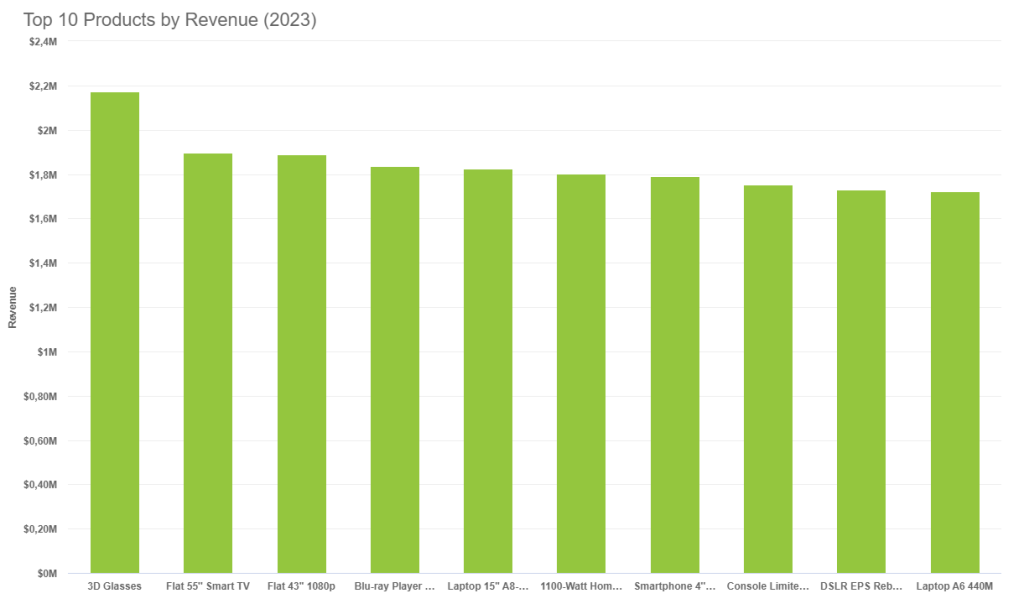
**click to enlarge**
Tools such as datapine, give users some design options to use a column chart with longer labels by changing the orientation of the labels. This can be seen in the example above which shows even the top 15 products with labels on the bottom. That said, this still looks bad and makes the chart visually busy. Thus, making the horizontal bar chart the best option to make the chart visually harmonic and easier to understand.
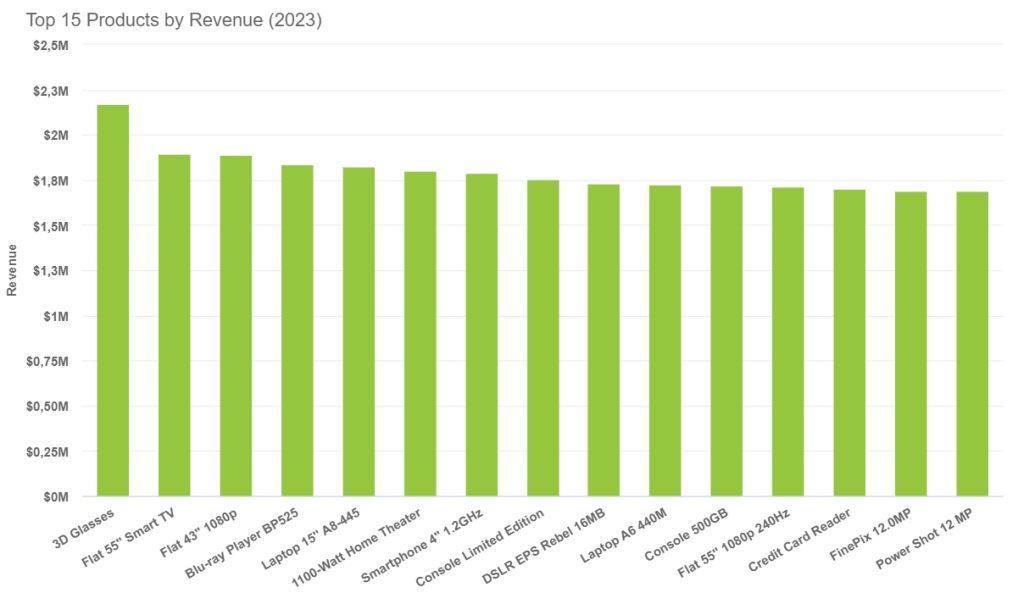
**click to enlarge**
2. Grouped bar chart
A grouped bar chart, also known as a clustered bar chart, is a variation of the traditional horizontal bar but instead of displaying one categorical variable, it displays two or more. When it comes to the design of this chart, the bars are displayed using different colors that represent the different categories. This can be seen in the example below, where the total customer service tickets by each channel are compared with the solved ones using different colors to easily identify the two values.
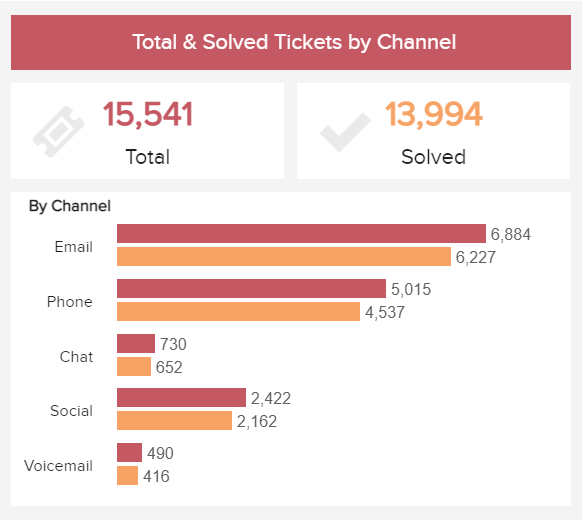
This type of bar graph is mostly used to show data distribution or comparison between categories and it can provide more detailed insights than the traditional type of bar chart as the categories can be compared within a specific group or across groups. Going back to our example, this graph can be used to extract conclusions from a specific channel, but also to compare the number of solved tickets within channels and drive conclusions that can lead to improving the service being provided.
3. Stacked bar chart
The stacked bar graph is a great tool to show how different subcategories influence a larger category. The way this is represented is by plotting all subcategories on top of each other forming a horizontal bar. The length of the horizontal bar will be determined by the total value of the larger category, while the length of the subcategories will be determined by their contribution to the larger one.
This is represented graphically in our example below. In which the answers to a customer survey on a company’s brand image are displayed. In this case, the length of the horizontal bar is represented by 100% of the answers and each subgroup is represented by a type of answer and the percentage of respondents that identified the brand with that specific characteristic. This is a great way to visually analyze if the brand is being perceived as expected by consumers or if some attributes need to be reinforced using promotional campaigns or other methods.

Stacked bar graphs are great visuals if you are trying to extract conclusions from categorical proportions within a group (as we saw previously with our example) or when you have data that is naturally divided into components such as sales by country, by quarter, by product, or others.
4. Dynamic bar chart – Interactive bar graph
Remember when we mentioned that one of the disadvantages of bar graphs was their simple nature? Well, this is not necessarily the case and our next type of bar graph will show you why.
The interactive (or dynamic) bar chart is basically a traditional bar chart that can be explored in real-time using interactive dashboard filters. This enables users to go into lower or higher levels of the data and extract more detailed conclusions from it.
Our example above is a video that shows an interactive bar chart that uses a drill down filter to go into lower levels of customer data. We first see the number of customers by country and then, by clicking on a specific country, we can see the number of customers by city. As mentioned previously, a horizontal bar graph is the best way to visualize this data as the lower level includes multiple cities that would likely not fit into another type of visual.
Bar Graphs & Charts Best Practices
Now that you know the most common bar chart types, let’s look into some best practices and tips on how to create them.
While it might sound fairly easy to gather some data and put it together in a bar chart, the process has its complexities and requirements in order to be successful. This is the case with any type of visual that you are trying to create. Each of them has a purpose and specific design requirements.
- Assess key considerations first
Before generating any type of visual, it is necessary to revisit your goals. Remember, that a bar chart is mainly used to compare categorical data, so, if your goal is not comparison then you should stop and think of another type of chart. Once that is out of the way, you can move on to other important considerations such as the context you will need to provide to make the data understandable.
When talking about context in data visualization we mean labels, titles, icons, and any other form of relevant information that makes the data more understandable for the user. To provide context you should make sure you are writing engaging titles and using extra legends only when necessary and in a way that will not overcrowd the graph or make the analysis process tedious.
In that regard, using a professional KPI dashboard is a great way to provide context and tell a complete data story. Dashboards enable you to integrate multiple charts in a centralized location, so you can generate extra charts to provide context and tell a story instead of overcrowding just one visualization.
A very common mistake that happens when plotting data using bar charts is the incorrect use of axes. This means, starting them in any other value that is not 0. This can not only make the differences between bars harder to understand, but it can also affect the truthfulness of the chart. Believe it or not, this is a practice that is widely used in the media, advertising, and politics as a way to mislead audiences into believing certain things that are not necessarily true. We already discuss this topic in our misleading statistics blog post in which we provided an example of a misleading bar chart by KFC. See the example below:
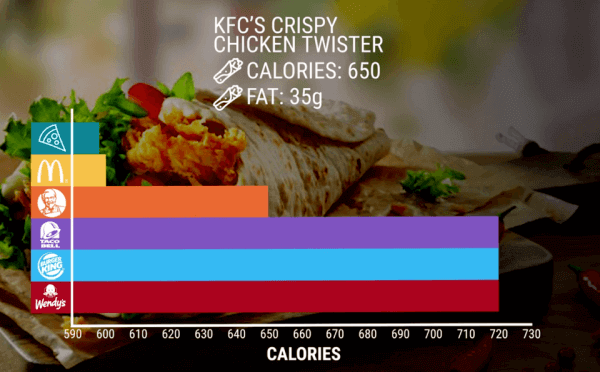
Source: Reddit “Data Is Ugly”
The issue here is that the numerical axis starts at 590 instead of 0, making it seem that KFC’s wrap has half the calories as the ones from Taco Bell, Burger King, or Wendy’s when is actually just 70 calories less.
- Keep a minimal design for bars
Some tools such as Excel offer users the possibility to get creative with the shape of the bars adding 3D effects, rounding the corners, or adding thick borders to them. In our experience, this is not the best course of action as the key to create a bar chart that is successful lies in simplicity. The more noise you add to your design, the more confusing and harder to understand it will be for the people that will have to work with it later.
This also applies when choosing the colors for the bars. Here, you want to avoid going crazy with fluorescent colors or colors that are visually harder to read such as bright red, brown, or even black. You should also avoid using multiple colors when it is not necessary. We recommend using variations of the same color to represent different categories when possible. That said, if you really need to differentiate between the categories, then pick a color palette that means something to your business or to your audience. Using colors that are already familiar or have some type of meaning behind them will make the audience perceive the graph in a more positive way.
Another important design tip is to be mindful of the spaces between the bars. Here, you should consider a space of roughly half of the width of each bar. As a result, the graphic will look more harmonious and more categories can be fit into the available space.
- Be mindful of the way categories are organized
While there is no rule of thumb to organize your categories, there are guidelines you can consider to make sure they are organized in a way that makes sense for the audience and for the purpose of the chart itself. For instance, if your goal is to show comparisons and your data is not sorted by time or other criteria that have a mandatory chronological order, then sorting them from highest to lowest or lowest to highest values will make the differences between each category more visually obvious for the audience.
Top 5 Bar Chart Examples For Different Business Functions & Industries
As you’ve probably learned by now, bar charts are powerful visuals that make data more accessible and understandable for everyone. To keep putting the value of this graphical tool into perspective, we will go through 5 bar chart examples for different business functions and industries generated with a professional bar graph maker.
1. Marketing
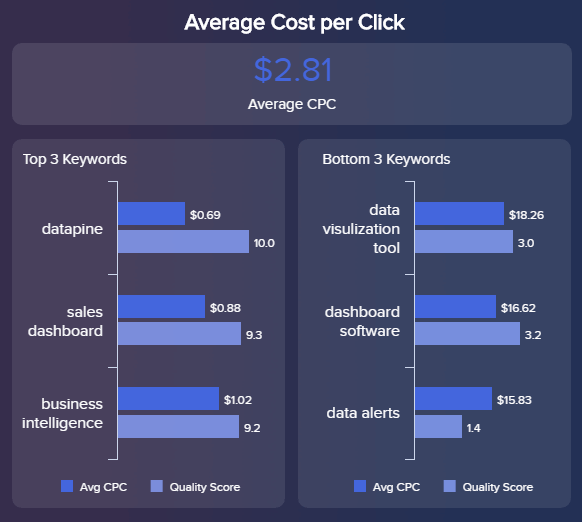
The first one in our list of bar graphs examples is a critical paid marketing KPI, the cost per click or CPC tracks the amount of money a business spends every time a person clicks on an ad. In this case, the CPC for the top and bottom keywords is displayed using a grouped bar chart with the quality score as the second category. This is valuable information as the average between the CPC and the quality score enables you to determine the position of an ad. Therefore, the grouped chart is a great tool to display this data.
2. Human Resources
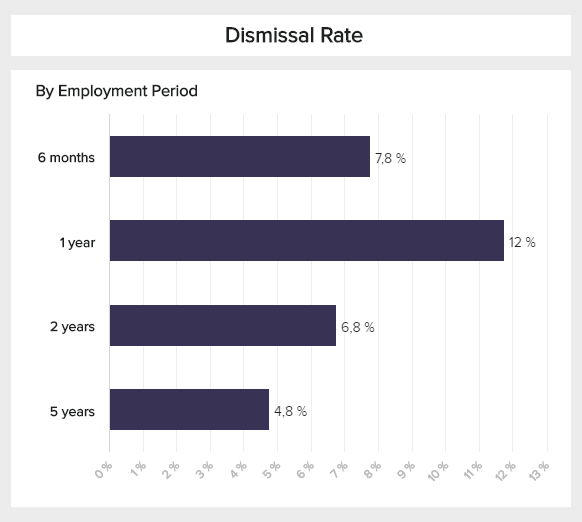
The next bar chart template is the dismissal rate. It is a valuable human resources KPI that enables the HR department to compare their turnover rates by employment period. Since the goal of this metric is comparison, the bar chart is a great choice to represent the data. In this case, the bars are organized from the smallest to the largest employment period so it is not possible to organize them in ascending or descending order. Regardless, it is not a critical matter as there are only 4 subcategories so the data is easily understandable at a glance.
3. Customer Service
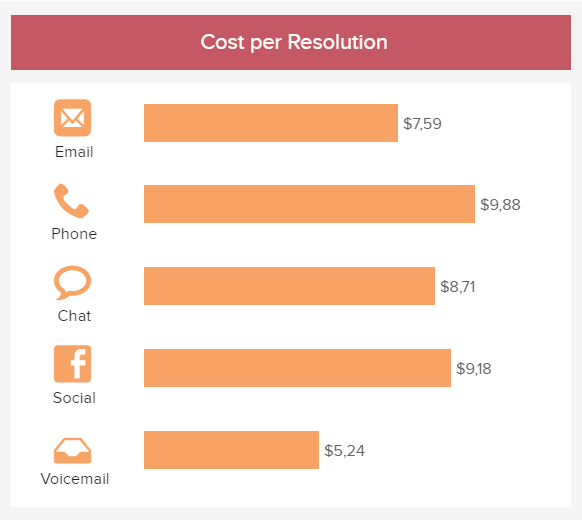
The cost per resolution is a great example of when to use a bar chart. This customer service KPI tracks the costs of resolving an issue through the different support channels. It is a great way to compare which channels are more efficient and which ones are not. In this case, complementing the information in a customer service dashboard can enable you to extract deeper conclusions. For example, you can see that the cost per resolution on the phone is the highest, by looking into another graph displaying the number of solved issues by channel you can see that the phone has the highest resolution rate, meaning costs are justified.
4. Healthcare

This next bar graph example is for healthcare analytics and it shows how this type of visual can enhance the service of a healthcare facility. The stacked bar chart above is tracking the average waiting time in minutes within two subgroups: time to see a doctor, and time to get treatment. The chart goes even further by providing a target of the maximum time a person should be waiting, making it possible to extract deeper conclusions. For instance, we can observe that three disciplines are above average, which is something that needs to be looked into to ensure high patient satisfaction levels.
5. Market Research
Our final example was generated with a bar chart maker and it shows data that is valuable for any type of organization no matter the industry or size: the number of customers by gender. In this case, the stacked bar chart is displaying data for the last 5 years with the subgroups showing the percentages of females and males completing 100% of customers for that year. What makes this visual so valuable is the fact that you can extract conclusions from specific years as well as compare them with each other. For example, we can see that from 2018 to 2022 the share of female and male customers went from 40-60% to almost 50-50%.
For more templates like these ones, visit our KPI examples library. We have more than 100+ templates for different industries, functions, and platforms.
Key Takeaways From Bar Charts
Throughout this insightful guide on the power of good bar charts, we hope you were able to graph the value of these visual tools. Bar graphs and charts are a great means to represent selected KPIs to support your decision-making process across all areas of your business. As you saw from our examples on different industries and departments including marketing, HR, customer service, finances, and more, bar charts are versatile graphics that can be used in many contexts. That said, their value increases even more when combined with other types of charts and visualized together in an interactive business dashboard.
By relying on the right tools and data visualization techniques you stand to be extremely successful with your analytical efforts. If you are ready to start generating stunning visuals to represent your most important business data, then try our professional online data visualization software for a 14-day free trial today!

